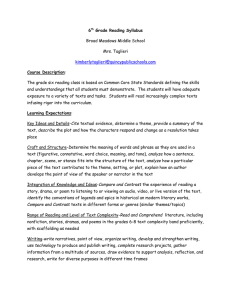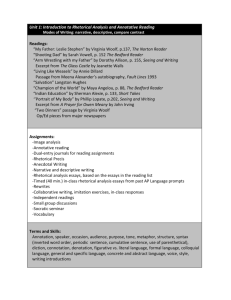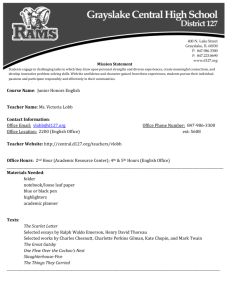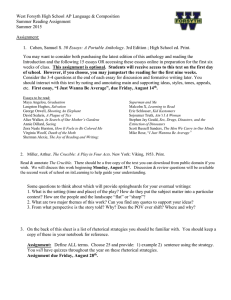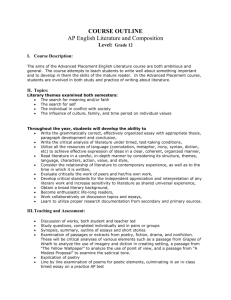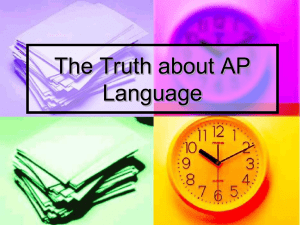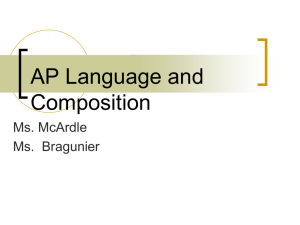AP® English Language and Composition 2013-2014
advertisement
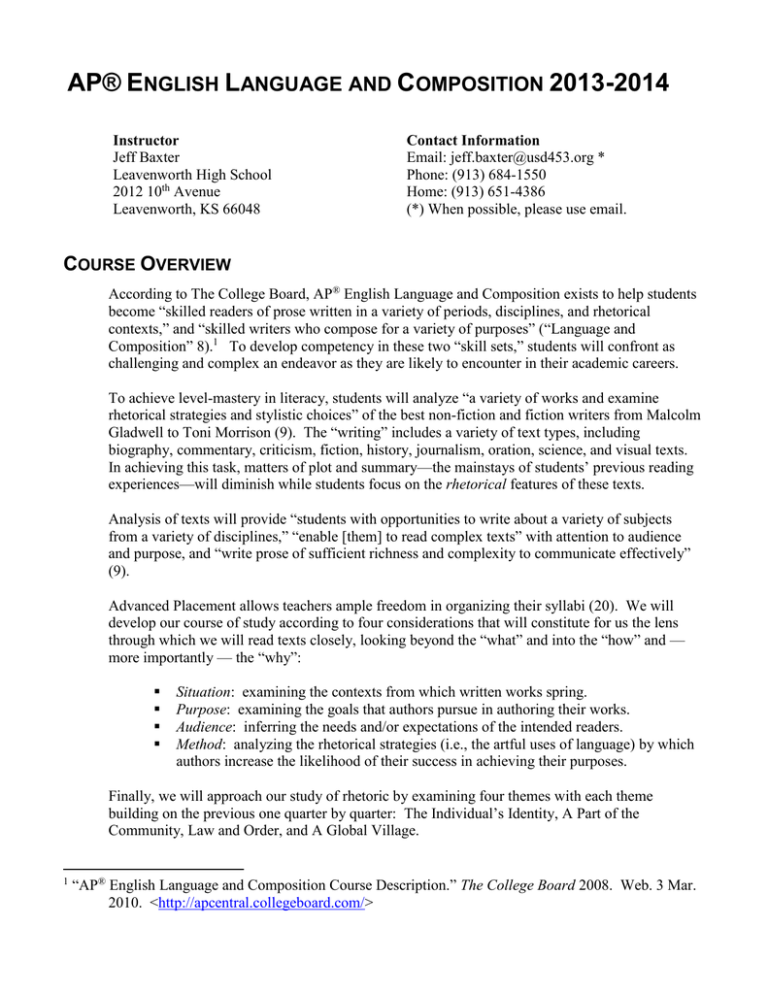
AP® ENGLISH LANGUAGE AND COMPOSITION 2013-2014 Instructor Jeff Baxter Leavenworth High School 2012 10th Avenue Leavenworth, KS 66048 Contact Information Email: jeff.baxter@usd453.org * Phone: (913) 684-1550 Home: (913) 651-4386 (*) When possible, please use email. COURSE OVERVIEW According to The College Board, AP® English Language and Composition exists to help students become “skilled readers of prose written in a variety of periods, disciplines, and rhetorical contexts,” and “skilled writers who compose for a variety of purposes” (“Language and Composition” 8).1 To develop competency in these two “skill sets,” students will confront as challenging and complex an endeavor as they are likely to encounter in their academic careers. To achieve level-mastery in literacy, students will analyze “a variety of works and examine rhetorical strategies and stylistic choices” of the best non-fiction and fiction writers from Malcolm Gladwell to Toni Morrison (9). The “writing” includes a variety of text types, including biography, commentary, criticism, fiction, history, journalism, oration, science, and visual texts. In achieving this task, matters of plot and summary—the mainstays of students’ previous reading experiences—will diminish while students focus on the rhetorical features of these texts. Analysis of texts will provide “students with opportunities to write about a variety of subjects from a variety of disciplines,” “enable [them] to read complex texts” with attention to audience and purpose, and “write prose of sufficient richness and complexity to communicate effectively” (9). Advanced Placement allows teachers ample freedom in organizing their syllabi (20). We will develop our course of study according to four considerations that will constitute for us the lens through which we will read texts closely, looking beyond the “what” and into the “how” and — more importantly — the “why”: Situation: examining the contexts from which written works spring. Purpose: examining the goals that authors pursue in authoring their works. Audience: inferring the needs and/or expectations of the intended readers. Method: analyzing the rhetorical strategies (i.e., the artful uses of language) by which authors increase the likelihood of their success in achieving their purposes. Finally, we will approach our study of rhetoric by examining four themes with each theme building on the previous one quarter by quarter: The Individual’s Identity, A Part of the Community, Law and Order, and A Global Village. 1 “AP® English Language and Composition Course Description.” The College Board 2008. Web. 3 Mar. 2010. <http://apcentral.collegeboard.com/> RESOURCES Anthologies American Short Stories. New York: McDougal Little, 2002. Print Kennedy, X. J., Dorothy M. Kennedy, and Jane E. Aaron. The Bedford Reader. 10th. Boston: Bedford / St. Martin’s, 2009. Print. Farrell, Edmund. Literature and the Language Arts: The American Tradition. St. Paul: EMC Paradigm, 2003. Print. Long-form Works Faulkner, William. As I Lay Dying. New York: Random House, 2000. Print. Fitzgerald, F. Scott. The Great Gatsby. New York: Scribner, 1992. Gladwell, Malcolm. Outliers: The Story of Success. New York: Back Bay Books, 2008. Print. Hosseini, Khaled. The Kite Runner. New York: Penguin, 2004. Print. Lawrence, Jerome and Robert E. Lee. Inherit the Wind. New York: Random House, 2003. Print. McCarthy, Cormac. All the Pretty Horses. New York: Knopf/Doubleday, 1992. Print. Melville, Herman. Moby Dick. New York: Random House, 1992. Print. Miller, Arthur. The Crucible. New York: Penguin, 2003. Print. Miller, Arthur. Death of a Salesman. New York: Penguin, 1998. Print. Morrison, Toni. Beloved. New York: Knopf/Doubleday, 2004. Print. Steinbeck, John. The Grapes of Wrath. New York: Penguin, 1992. Print. Other Student Resources Eidenmuller, Michael. American Rhetoric. 2001-2010. Web. 2 Mar. 2010. Hacker, Diana, Nancy Sommers, and Tom Jehn. The Bedford Handbook. 8th. Boston: Bedford/St. Martin’s, 2010. Print. Strunk, William and E. B. White. The Elements of Style. New York: Longman, 1999. Print. Teacher Resources The Atlantic Monthly. Axelrod, Rise, and Charles Cooper. The St. Martin’s Guide to Writing. 9th. Boston: Bedford/St. Martin’s, 2010. Print. Barnett, Timothy. Teaching Argument in the Composition Course. Boston: Bedford/St Martin’s, 2002. Print. Bullock, Richard and Maureen Daly Goggin. The Norton Field Guide to Writing with Readings. 2nd. Saddle Brook, NJ: W. W. Norton, 2010. Print. Cooley, Thomas. The Norton Sampler. Saddle Brook, NJ: W. W. Norton, 2010. Print. Lunsford, Andrea A., John J. Ruskiewicz, and Keith Walters. Everything’s an Argument. 5th. Boston: Bedford / St. Martin’s, 2010. Print. The New York Times. The New Yorker. Rankin, Estelle and Barbara Murphy. 5 Steps to a 5 AP Language. New York: McGraw-Hill, 2009. Print. Shea, Renee, Lawrence Scanlon and Robin Aufses. The Language of Composition. Boston: Bedford / St. Martin’s, 2008. Print. The Wall Street Journal. Weston, Anthony. A Rulebook for Arguments. 4th. Indianapolis: Hackett, 2009. Print. ASSIGNMENT TYPES Annotation, (Cornell) Notes, and Purpose-driven Readings: In lieu of reading quizzes, students in this course will regularly create and submit annotations or notes. Annotations will be the mainstay during the fall when the majority of our readings will be of documents that have passed into the public domain. For texts still under copyright, we will employ Cornell notes and purpose-driven readings.2 In both semesters, this work will serve to “jump start” discussions; students will identify the situations, purposes, audiences, and methods at play in their texts (on occasion we will employ SOAPSTone) ; they will also provide journal entries to demonstrate their progress towards mastery in analyzing the effects that rhetorical structures create in texts. Visual Literacy Exercises: Working from the premise that analyzing visual texts can provide students with a comfortable stepping-off point into reading for rhetoric rather than plot, we will regularly take time to view and discuss works of visual art such as advertisements, comic strips, editorial cartoons, paintings and sculptures. Students will find that these works also demonstrate the principles of situation, purpose, audience, and method, bearing a sometimes uncanny resemblance to the academic works that will be at the heart of our studies. We will also employ the OPTIC strategy for understanding visual texts. Daily Participation: Participation is the cornerstone of any AP course. Students who arrive to class expecting to be fed information should consider enrolling elsewhere. Quizzes: These assignments will strike a balance between knowledge and skill, sometimes asking for close-reading responses and at other times for the ability to apply previously learned ideas to new situations. Unit Exams and Semester Exams: The key word for exams is comprehensive. When students review and renew their knowledge so that they may synthesize it into a larger whole, knowledge begins to be fashioned into comprehension and even wisdom. Students should expect exams to place a premium on evaluating the ideas we have studied, as well as the progress they themselves have made as thinkers and writers. Analytical/Expository Writing – Columnist Project: Each month, students will bring to class a current column by a regular columnist of their choice. Before arriving, they should annotate the column for the following traits: tone, methods (schemes and/or tropes), and logical appeals. Over a two-week cycle, they will compose a well-supported three- or four-paragraph response to the column (MLA guidelines apply). For full credit, the responses three paragraphs must (1) summarize the author’s main point, (2-3) analyze the author’s most salient rhetorical strategies, (4) evaluate the article’s effect on the reader.3 Analytical/Expository Writing – Focus Essays: As described in Pearl Amelia McHaney’s article “Let Every Voice Be Heard: Focus Essays Create Democratic Classrooms,” (English 2 All three strategies will be explained during the first few days of school. Students will receive adequate modeling and practice before being required to produce notes of their own. 3 Notes on the essay-writing process: Except on rare occasions, students will follow a multi-stage essay writing process mimicking that of professionals in the field of English: pre-writing/information gathering, drafting, peer editing and reflection, final drafting, reflection on evaluative comments from the teacher, (conferring with the teacher about the draft), and providing a corrected/improved final draft. Journal Vol. 93, No. 5 May 2004) focus essays are short, tightly written essays expounding upon a single point or aspect of literature. Never exceeding two paragraphs in length, focus essays require from students a careful consideration of purpose, method, and effect; moreover, they have the benefit of requiring frequent reinforcement of MLA strictures for formatting and citations. Argumentative/Persuasive Business Writing: For the purpose of cementing in students’ minds centrally important concepts of audience awareness, tone, and voice, students will write a “realworld” business letter, arguing for a real outcome, to be sent to a real addressee after the teacher’s final evaluation of the work. Argumentative/Persuasive Critical Writing: As a warm-up exercise prior to the multi-source “academic” arguments in middle spring, students will review a movie or local restaurant and write a review. Recently published reviews will serve as models. Argumentative/Persuasive Academic Writing: Students will write two formal, researchenhanced arguments, one according to MLA style, and the other in AP format. For the first essay, students must write about a literary topic; for the second, they will enjoy nearly limitless freedom in topic selection. Both essays will require students to consider primary and secondary sources. Documentary Film Analysis. Using Renee Shea’s curriculum module “Using Documentary Film as an Introduction to Rhetoric,” students will view several documentaries (the award-winning Spellbound and When the Levees Broke, for example) students will be introduced to ethos, logos, and pathos. They will analyze the rhetorical strategies and devices in a comprehensive review of the film modeled after those of Roger Ebert and other film critics. Derivative Poetry: In conjunction with analyzing Ginsberg’s “Is About” (fall) and Williams’s “This Is Just to Say” (spring), students will write a derivative poem of approximately equal length, whose literary-rhetorical characteristics they will annotate so as to demonstrate concepts from the AP Rhetorical Map. Derivative Prose: After reading and analyzing Alice Walker’s “In Search of Our Mother’s Gardens,” students will create their own biographical essays, in which they will explore the significance that a close friend or relative has had on their own development as thinkers, writers, or participants in the human drama. Timed Writings (Prompts): A mainstay of the spring schedule, timed writings will occur every other week. Students will evaluate each others’ essays, and then reflect on their own strengths and weaknesses, as judged against exemplars provided by The College Board, previous years’ students, or the course instructor. Unlike all the above-listed essays, in-class essays will be deemed formative assessments. Students’ grades will depend upon their reasonable completion of the tasks, not their proficiency in writing under pressure. STUDENT EVALUATION Daily Assignments: 10 pts each assignment, with deductions for failures to complete/participate. Daily Quizzes: 10 pts. Unit Assessments: 100 pts. First-quarter Essays: 25 pts., with the opportunity to revise for a new grade; Second-quarter Essays: 50 pts., with the opportunity to revise for an averaged grade; Third-quarter Essays: 75 pts., with the opportunity to revise for an averaged grade. Fourth-quarter Essays: 100 pts., no revisions. (Students are expected by this time to have developed their own editing process, modeled after the teacher’s method of evaluating their writing.) Each semester consists of roughly eighteen weeks. I compute the semester grade according to the following cumulative model: SEMESTER GRADE = (.8)(18 WEEKS) + (.2)(FINAL EXAM) Interpretation of Grades: A (90-100): The student’s work is excellent to exemplary, capable of being used as a demonstration of “what to do” for future AP students. B (80-89): The student’s work is adequate, demonstrating the effective mastery of many essential skills, yet with demonstrable room for improvement; such work would likely earn a B- or C in a college course. C (70-79): The student’s work, though significantly stronger than that of the “average” high school student, is still inadequate—somewhat below what would be acceptable in the college environment. Students still earning Cs on essays, examinations, and quizzes by the end of the first semester should consider carefully whether to continue in AP English through the spring semester. D (60-69): The student’s work demonstrates little success, far below that of collegelevel work, and even below that which should be expected from the average high school student. CHEATING AND PLAGIARISM POLICY I do not tolerate cheating of any kind in my classroom. Any student caught cheating will receive a zero on the assignment in question and an office referral; the student’s parent will receive a phone call or a letter and the request for a meeting. I view these situations as teachable moments, and take the time for clear understanding with student and parent. Plagiarism is cheating and will be dealt with accordingly. However, when plagiarism is deemed to be the result of sloppy workmanship, the student will be allowed the opportunity to correct the work, suffering a lettergrade deduction on the assignment. QUARTERLY UNIT OVERVIEWS QUARTER 1 / UNIT 1: THE INDIVIDUAL’S IDENTITY ESSENTIAL QUESTION: What are the factors that shape an individual’s identity? MAJOR ASSERTION: Defend, challenge, or qualify the following statement by Adah in Barbara Kingsolver’s The Poisonwood Bible: “Tall and straight I may appear, but I will always be Adah inside. A crooked little person trying to tell the truth. The power is in the balance; we are our injuries, as much as we are our successes.” The major concern for the first quarter revolves around students’ need for a basic skill set with which to analyze written works and then comment intelligently upon them. Accordingly, assigned texts and essays are comparatively brief, affording students the ability to focus on building skills rather than completing tasks. The teacher will provide generous modeling and reinforcement this quarter. Practice of skills will be primarily — though not exclusively — collaborative in nature. Assessments will lean toward the formative in nature, taking care to be sure students are implementing rhetorical strategies and developing insightful study practices. Moreover, the teacher will be concerned primarily with determining the degree to which students are arriving at knowledge and comprehension of the ideas below. Texts (Visual Arts, Oration, Poetry, Short Fiction, Long Fiction/Drama, Essay, Film) Da Vinci, Leonardo. “Grotesque Profile.”4 Lange, Dorothea. “Migrant Mother.” McCurry, Steve. “Sharbat Gula.” Munch, Edward. “The Scream.” Picasso, Pablo. “The Old Guitarist.” Rodin, Auguste. “The Thinker.” Carmichael, Stokely. “Black Power.” Faulkner, William. “Nobel Acceptance Speech.” Collins, Billy. “Introduction to Poetry.” Connolly, Geraldine. “The Summer I Was Sixteen.” Dickinson, Emily. “Because I Could Not Stop for Death,” “I Heard a Fly Buzz,” “The Soul Selects Her Own Society,” “’Hope’ is the thing with feathers-.” Ginsberg, Alan. “Is About.” Poe, Edgar Allan. “The Raven.” Whitman, Walt. “I Hear America Singing,” Song of Myself 10, 33. Faulkner, William. “Tall Soldiers.” Hawthorne, Nathaniel. “Rappaccini’s Daughter.” Poe, Edgar Allan. “The Tell Tale Heart.” Tan, Amy. “Fish Cheeks.” Faulkner, William. As I Lay Dying. Gladwell, Malcolm. Outliers: The Story of Success. Miller, Arthur. Death of a Salesman. Angelou, Maya. “Champion of the World.” Cisneros, Sandra. “Only Daughter.” Danticat, Edwidge. “Not Your Homeland.” Edwards, Jonathan. “Sinners in the Hands of an Angry God.” Emerson, Ralph Waldo. “Nature,” “Self-reliance.” Pound, Ezra. “The River Merchant.” Rosenblatt, Roger. “We Are Free to Be You and Me.” Staples, Brent. “Black Men and Public Space.” Blitz, Jeffrey. Spellbound (or Louder Than a Bomb) Literacy Annotating 101, adapted from lectures given by Professors Quinn and Nellick at the University of Kansas. 4 This quarter’s visual arts are a purposely disparate selection of the individual. Students will be introduced to O-P-TI-C as a strategy for evaluating visuals while at the same considering S-P-A-M. The Cornell Method. Criticism and Theory Literary Criticism: archetype, free verse, literary romance, magical realism, motif, point of view, satire, transcendentalism. Literary Theory: new criticism, structuralism. Rhetoric and Style S(ituation) P(urpose) A(udience) M(ethod) model of basic textual analysis. O(verview) P(arts) T(itle) I(nterrelationships) C(onclusion) model of visual analysis. Modes of Discourse: cause/effect, dialogue, description, example, narration, process analysis, summary. Schemes: alliteration, anaphora, assonance, catalog, consonance, denotation, parallelism, repetition, rhyme. Tropes: allegory, allusion, anecdote, connotation, figure of speech, imagery, irony, juxtaposition, metaphor, onomatopoeia, oxymoron, paradox, parable, personification, symbol, tone. Grammar, Mechanics, and Style Concepts Prerequisite to College Writing—the “Top 10”: DET(ails), DEV(elopment), ¶ (hierarchical), TRANS(itions), 1st/2nd (avoiding informal/inaccurate point-of-view constructions), DEAD (avoiding dull language), FRAG(mentary sentences), CS/FUSED (sentences), EXPLET(ives), P(assive)V(oice). MLA document formatting, citing simple works. Scholarship and Composition. Derivative Prose: narratives patterned on the stories of Angelou, Cisneros, Danticat, and Staples. Derivative Poetry: “Is About” poems. Compositions: focus essays, analysis, narrative. QUARTER 2 / UNIT 2: A PART OF THE COMMUNITY ESSENTIAL QUESTION: From a individuals in a common location, how does community develop? MAJOR ASSERTION: Defend, challenge, or qualify the following statement by Elie Wiesel: “This is the duty of our generation as we enter the 21st century – solidarity with the weak, the persecuted, the lonely, the sick, and those in despair. It is expressed by the desire to give a noble and humanizing meaning to a community in which all members will define themselves not by their own identity but by that of others.” The pace quickens in the second quarter as we assume the following: (1) that students can use basic reading skills (annotations, Cornell notes) competently; (2) that they have gained basic familiarity with the AP III Rhetorical Map and the SPAM model; (3) that they have eradicated the vast majority of “Top 10” compositional errors; and (4) that they have mastered MLA formatting guidelines and citation protocols for anthologized short works and singly-published long works. Because the Essential Question implies an argumentative/persuasive response from the individual, we will turn our attention to analyzing and producing solid arguments. Collaborative discussions will begin yielding ground to individually produced composition. The teaching style will become more Socratic. Students will engage in heavily metacognitive thinking about their work, looking for weaknesses to be transformed into strengths. Assessments will continue to lean toward the formative. However, the teacher will be looking for the skillful application of sound rhetorical strategies, not simply a recognition of these in action. Texts (Visual Arts, Oration, Poetry, Short Fiction, Long Fiction/Drama, Essay, and Film) Adams, Ansel. “Freeway Interchange.” Johnson, William H. “Street Life.” Morton, Margaret. “Doug and Mizan’s House.” Thompson, Mike. “Garbage In.” Wood, Grant. “American Gothic.” Becker, Harold. “Mayor Eulogizes James” from City Hall. King, Jr., Martin Luther. “I Have a Dream.” Welch, Joseph. “Have You No Decency?” Bradstreet, Anne. “Upon the Burning of Our House.” Dunbar, Paul Laurence. “We Wear the Mask” Eliot, T. S. “The Love Song of J. Alfred Prufrock.” Frost, Robert. “Mending Wall,” “Choose Something Like a Star.” Hughes, Langston. “I, too, sing America.” Longfellow, Henry Wadsworth. “The Village Blacksmith.” Masters, Edgar Lee. “Lucinda Matlock” from Spoon River Anthology. Ortiz, Simon. “Hunger in New York City.” Jackson, Shirley. “The Lottery.” Morrison, Toni. from The Bluest Eye. Twain, Mark. “The Man That Corrupted Hadleyburg.” Walker, Alice. “Roselily.” Fitzgerald, F. Scott. The Great Gatsby. McCarthy, Cormac. All the Pretty Horses. Ascher, Barbara Lazear. “On Compassion.” Ehrenreich, Barbara. “The Roots of War.” Kingston, Maxine Hong. “No Name Woman.” Naylor, Gloria. “The Meanings of a Word.” Quindlen, Anna. “Homeless.” Rodriquez, Richard. “Aria: A Memoir of a Bilingual Childhood.” Rosenblatt, Roger. “We Are Free to Be You, Me, Stupid, and Dead.” Santee, Luc. “What Secrets Tell.” Williams, Brian. “But Enough About You…” Lee, Spike. When the Levees Broke. Literacy (As in 1st quarter, but with the expectation of skillful application.) Criticism and Theory Literary Criticism: characterization, dialect, diction, episodic narrative, Harlem Renaissance, literary realism, malapropism, parody, picaresque hero, primary source, regionalism, satire, secondary source, voice. Literary Theory: deconstruction, new historicism. Rhetoric and Style (As in 1st quarter, but with the expectation of skillful application.) Logical Appeals: logos (and logical fallacies), ethos, pathos. Modes of Discourse: argument/persuasion, cause/effect, comparison/contrast, definition, division/analysis, narration. Schemes: alliteration, anaphora, chiasmus, denotation, description, diction, meter, organization, parallelism, pun, repetition, syntax. Tropes: allusion, analogy, anecdote, connotation, idiom, irony, litotes, metaphor, metonymy, oxymoron, paradox, personification, simile, synecdoche. Grammar, Mechanics, and Style Avoiding Punctuation Headaches: colons, commas, dashes, semicolons, parentheses. MLA document formatting, citing anthologized works and simple online texts. Scholarship and Composition. Analytical/Evaluative Writing: focus essays, original analysis, persuasion, argument (intro). Argumentative/Persuasive Business Writing: business letter. QUARTER 3 / UNIT 3: LAW AND ORDER ESSENTIAL QUESTION: To what extent do laws appropriately limit freedom in American society? MAJOR ASSERTION: Defend, challenge, or qualify the following statement by Charles T. Spradling from Freedom and its Fundamentals: “Although the legal and ethical definitions of right are the antithesis of each other, most writers use them as synonyms. They confuse power with goodness, and mistake law for justice.” Students will continue engaging in heavily metacognitive thinking about their work. In quarter three, the teacher will have the students suggest “next steps” for classroom discussions and practice sessions. At the same time, assessments will begin leaning away from the formative and toward the summative, with proficiency surpassing participation as the major determinant of students’ evaluations. The teacher will work from the assumption that conscientious students have developed the skills to anticipate and avoid most of their common errors. Texts (Visual Arts, Oration, Poetry, Short Fiction, Long Fiction/Drama, Essay) Art Deco Architecture and Art. Dali, Salvador. “Premonition of Civil War.” Forman, Stanley. “The Soiling of Old Glory.” Homer, Winslow. “The Gulf Stream.” Lesser, Erik. “Deployed Soldier and His Daughter.” Darrow, Clarence. “Mercy for Leopold and Loeb.” Giovanni, Nikki. “We Are Virginia Tech.” Zinneman, Fred. “Thomas More Addresses the Court” from A Man for All Seasons. Cullen, Countee. “Any Human to Another,” “Yet Do I Marvel.” Eliot. T. S. “The Hollow Men.” Holmes, Oliver Wendell. “The Chambered Nautilus.” Hughes, Langston. “Dream Deferred,” “Let America Be America Again,” “Theme for English B.” Lowell, Amy. “Patterns.” Lowell, James Russell. “Stanzas on Freedom.” McKay, Claude. “If We Must Die.” Pound, Ezra. “In a Station of the Metro,” “The River Merchant’s Wife: A Letter.” Williams, William Carlos. “The Red Wheelbarrow,” “To a Poor Old Woman.” Hemingway, Ernest. “Soldier’s Home.” O’Connor, Flannery. “Everything That Rises Must Converge.” Wright, Richard. “The Man Who Saw the Flood.” Lawrence, Jerome and Robert E. Lee. Inherit the Wind. Melville, Herman. Moby Dick. Chavez, Linda. “Everything Isn’t Racial Profiling.” Colson, Charles. “Gay Marriage: Societal Suicide.” Divakaruni, Chitra. “Live Free and Starve.” Krikorian, Mark. “Safety Through Immigration Control.” Orwell, George. “Shooting an Elephant.” Swift, Jonathan. “A Modest Proposal.” Vowell, Sarah. “Shooting Dad.” Literacy (As in 1st and 2nd quarters, but with continually more sophisticated application.) Criticism and Theory Literary Criticism: ballad stanza, foreshadowing, Harlem Renaissance, imagism, modernism, protagonist, setting. Literary Theory: cultural studies, new historicism. Rhetoric and Style (As in 1st and 2nd quarters, but with continually more sophisticated application.) Modes of Discourse: dramatic monologue, narration. Schemes: caesura, denotation, juxtaposition, meter, repetition, rhetorical question, rhyme, rhythm. Tropes: allusion, connotation, figure of speech, idiom, imagery, irony, metaphor, paradox, symbol. Grammar, Mechanics, and Style Matters of Style: conciseness, clarity, and sentence variety (including cumulative and periodic sentences, as well as matters of coordination and subordination). MLA document formatting, citing “unusual” texts. Scholarship and Composition. Analytical/Evaluative Writing: focus essays, argument, columnist project. Argumentative/Persuasive Critical Writing: movie/restaurant review. Timed Writings: AP prompts. QUARTER 4 / UNIT 4: A GLOBAL VILLAGE ESSENTIAL QUESTION: Given current tensions, is world peace possible? MAJOR ASSERTION: Defend, challenge, or qualify the following statement by former President Bill Clinton: “The real differences around the world today are not between Jews and Arabs; Protestants and Catholics; Muslims, Croats, and Serbs. The real differences are between those who embrace peace and those who would destroy it; between those who look to the future and those who cling to the past; between those who open their arms and those who are determined to clench their fists.” With a bag of tricks now well on its way to being sufficiently stocked, we will examine closely the requirements of the AP English Language exam. Meanwhile, proficiency has replaced participation in student evaluations. Students earn grades commensurate with the fulfillment of college-level expectations. Texts (Visual Arts, Oration, Poetry, Short Fiction, Long Fiction/Drama, Essay, Film) English, Ron. “Money is the Root of All Evil.” Lea, Tom. “The 2000-Yard Stare.” Lichtenstein, Roy. “Blam.” Malik, Samir. “Haqq.” Rockwell, Norman. “The Golden Rule.” Bush, George W. “9/11 Address to Congress.” Kennedy, John F. “Inaugural Address.” Roosevelt, Franklin D. “Pearl Harbor Address.” Bryant, William Cullen. “Thanatopsis.” Crane, Stephen. “Do not weep, maiden, for war is kind.” Dickinson, Emily. “This is my letter to the World.” Dove, Rita. “Wingfoot Lake.” Emerson, Ralph Waldo. “The Rhodora.” Ferlinghetti, Lawrence. “Constantly risking absurdity.” Plath, Sylvia. “Morning Star.” Alexie, Sherman. “This is What It Means to Say Phoenix, Arizona.” Cather, Willa. “A Wagner Matinee.” Malamud, Bernard. “The Magic Barrel.” O’Brien, Tim. “Ambush.” Oates, Joyce Carol. “Journey.” Hosseini, Khaled. The Kite Runner. Steinbeck, John. The Grapes of Wrath. Ayad, Laila. “The Capricious Camera.” Ericsson, Stephanie. “The Ways We Lie.” Khan, Adnan. “Close Encounters with US Immigration.” Krull, Andrew Koritz. “Celebrating the Pity of Brotherly Love.” Said, Edward. “Clashing Civilizations.” Wurster, Andie. “Won’t You Be My Friendster.” Longley, James. Iraq in Fragments. Literacy (As in 1st, 2nd, and 3rd quarters, but with continually more sophisticated application.) Criticism and Theory Literary Criticism: absurdity, ambiguity, blank verse, characterization, epistolary novel, postmodernism, satire, villanelle. Literary Theory: gender studies, postcolonial studies, psychoanalytic criticism. Rhetoric and Style (As in 1st, 2nd, and 3rd quarters, but with continually more sophisticated application.) Modes of Discourse: classification, comparison/contrast, division/analysis. Schemes: alliteration, assonance, meter, parallelism, rhyme. Tropes: imagery, onomatopoeia, paradox, simile, symbol. Grammar, Mechanics, and Style Show-stopping Introductions and Conclusions: focused attention on the effective strategies of recently published essays. Scholarship and Composition. Analytical/Evaluative Writing: focus essays. Argumentative/Persuasive Academic Writing: research-enhanced critical analysis (MLA), research-enhanced argument (AP style). Timed Writings: Synthesis Writing and AP prompts.
